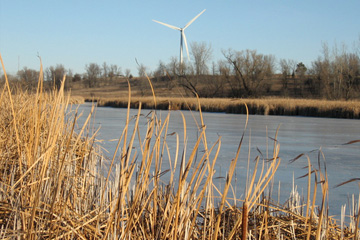Using decades-old data researchers have proven a long-suspected effect of wind turbines: under certain conditions large-scale wind farms can change local weather. Temperatures recorded from a wind farm in San Gorgonio, California in 1989 shows that turbines cooled local temperatures during the day, but warmed them at night. However, researchers in the paper published in the Proceedings of the National Academy of Science say that the impact of wind farms on local temperatures will not be the same everywhere.
“It depends on the location,” Somnath Baidya Roy, one of the paper’s authors, said. “For example, in the Great Plains region, the winds are typically stronger at night, so the nocturnal effect may dominate. In a region where daytime winds are stronger—for example a sea breeze—then the cooling effect will dominate. It’s a very location-specific thing.”
 Wind turbine in Morris, Minnesota. Photo by: Jeremy Hance. |
Roy had already shown that turbines when built on a massive scale could impact temperature using computer modeling, but discovery of data taken when Nintendo’s Game Boy was the newest in entertainment technology proved the first observational record of such phenomena.
Researchers write that wind farms impact temperature simply by stirring the air around: turbine rotors cause turbulence, bringing down upper-level air while pushing up surface-level air and mixing them enough to change temperature.
Researchers say this phenomenon could actually have some benefits. For example, wind turbines built over farmland in the Midwest would warm air at night, possibly extending the growing season and providing some protection from frost.
Mitigating the impact is also possible by developing low-turbulence turbine rotors, which would also be more energy efficient. Another solution would be to place wind farms in regions of the world where turbulence is already present in the atmosphere, thereby lessening the importance of wind turbine-related turbulence, such as the American Midwest.
“Wind energy is likely to be a part of the solution to the atmospheric carbon dioxide and the global warming problem. By identifying impacts and potential mitigation strategies, this study will contribute to the long-term sustainability of wind power,” Roy said.
Related articles
U.S. approves first offshore wind farm
(04/28/2010) The Obama Administration has approved the nation’s first offshore wind farm after more than eight years of legal challenges, reports the Associated Press.
China leaves US (and Europe) in the dust on renewable energy
(02/01/2010) This year China has become the world’s largest manufacturer of solar panels and wind turbines, doubling its wind capacity since 2005. The economically booming nation—and the world’s most populous—has also invested heavily in nuclear power and the world’s most efficient coal plants, according to the New York Times.
Wind could power the entire world
(06/22/2009) Wind power may be the key to a clean energy revolution: a new study in the Proceedings of the National Academy of Science finds that wind power could provide for the entire world’s current and future energy needs.